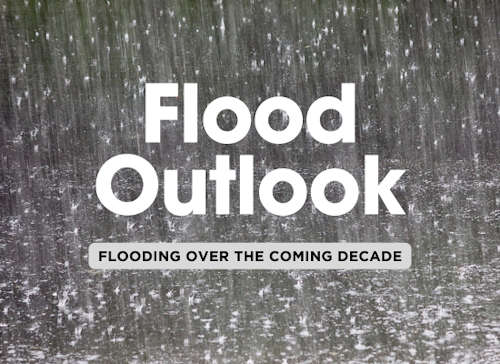As we navigate a rapidly changing climate, the next decade brings an increased likelihood of severe weather events, especially flooding. Preparing for this future means understanding the driving forces behind rising flood risks. From warming oceans to shifting urban landscapes, here’s a breakdown of what’s fueling these changes:
📈 Key Drivers of Rising Flood Risks
🌡️ Climate Change and Global Warming
- Rising Temperatures: The global temperature is on an upward trend, melting glaciers and ice caps faster than ever. This adds more water to the oceans, leading to higher sea levels 🌊 and increasing the risk of coastal and inland flooding.
- Melting Ice Caps and Glaciers: Polar ice caps and glaciers, especially in the Arctic and Antarctica, are rapidly melting. The water volume added to oceans is a key contributor to sea level rise, impacting coastal areas and low-lying islands significantly.
- More Intense Rainfall Events: Warmer air holds more moisture 🌧️, leading to more frequent, intense rainfall. This means some areas that previously experienced moderate rainfall may now see flash floods during heavy rain events.
🌊 Rising Sea Levels
- Coastal Flooding: For communities near coastlines, rising sea levels are creating regular “nuisance flooding” (or “sunny day” flooding), where areas flood without any rain due to high tides alone 🌅. Low-lying areas like Miami and Venice already see this effect, which could become more common.
- Slow River Drainage: When sea levels are higher, river water has a harder time flowing into the ocean, causing it to back up and flood upstream areas. This puts riverside communities at a higher risk of unexpected flooding.
🌀 Increased Storm Intensity
- Stronger Storms: Warmer oceans provide more energy for storm systems, causing hurricanes, typhoons, and cyclones to grow in intensity. When these storms make landfall, they bring increased rainfall and storm surge 🌪️, leading to massive flood risks for coastal and inland regions.
- More Frequent Storm Surges: Rising sea levels mean storm surges reach further inland than before, causing more damage. Coastal cities, in particular, are vulnerable to these surges, which are expected to intensify.
🏙️ Land Use and Urbanization
- Expanding Urban Areas: As cities grow, natural land areas that absorb water (like wetlands) are replaced by concrete and asphalt. This urban sprawl means more rainwater turns into surface runoff, increasing the risk of urban flooding. Areas like Houston have seen worsening flood impacts due to rapid urbanization.
- Deforestation and Agriculture: Forests and other natural barriers help absorb excess rainwater and prevent erosion. But when large areas are cleared for farming 🌾 or development, soil loses its ability to retain water, creating a higher risk of flash floods during storms.
- Soil Degradation: Areas suffering from over-farming and erosion have a weakened ability to absorb rainwater. Poor soil quality contributes to increased runoff during rainfall, making flash floods more common.
🌱 Ecological Impacts
- Wetland Degradation: Wetlands act as natural flood buffers, absorbing excess water and releasing it slowly. When wetlands are drained or degraded, this natural buffer is lost, leading to faster and more severe flooding in areas that once relied on them for protection.
- Riverbank Erosion: As riverbanks erode from human activity and climate change, rivers can overflow more easily, impacting nearby towns and cities during storms.
| Region | Primary Flood Risks | Contributing Factors | Risk Level | Historical Trends |
|---|---|---|---|---|
| North America | Coastal flooding, River flooding | Sea level rise, Urbanization, Intense storms | High | Increasing frequency of extreme rainfall and hurricanes |
| Europe | River flooding, Flash floods | Heavy rains, Soil degradation, Wetland loss | Medium | Higher temperatures and seasonal flooding spikes |
| Southeast Asia | Monsoon floods, Storm surges | Intense monsoon seasons, Coastal erosion | High | Monsoon intensity increasing yearly |
| South America | River flooding, Coastal flooding | Deforestation, Urban expansion | Medium | More frequent floods along major rivers like the Amazon |
| Africa | Flash floods, Coastal flooding | Poor drainage systems, Deforestation | High | Rising flood events due to poor infrastructure |
| Australia | Coastal flooding, River flooding | Sea level rise, Extreme heat, Wildfires impacting soil | Medium | Severe flood events linked to extreme weather patterns |
Regional Flood Outlooks
🌎 North America
- Key Risks: Coastal flooding, River flooding
- Vulnerable Areas: East Coast, Gulf Coast, major river systems (Mississippi, Missouri)
- Drivers of Risk:
- Sea Level Rise: Coastal areas along the Atlantic and Gulf of Mexico are already seeing increased flooding due to rising sea levels, with predictions that parts of Florida and Louisiana could see regular inundation.
- Increased Storm Intensity: More frequent and intense hurricanes bring high storm surges and heavy rainfall, affecting both coastal and inland regions.
- Urbanization: Expanding cities like Houston face severe flooding risks, as concrete surfaces prevent water absorption, leading to increased runoff and flash floods.
🌍 Europe
- Key Risks: River flooding, Flash floods
- Vulnerable Areas: Central Europe (Germany, Poland), Mediterranean regions
- Drivers of Risk:
- Heavy Rainfall: Regions along the Rhine and Danube rivers have seen significant flooding due to prolonged periods of rainfall, especially during spring and summer.
- Soil Degradation and Urbanization: The loss of forests and green spaces has reduced natural barriers to flooding, particularly in Southern and Eastern Europe.
- Climate Variability: Changing weather patterns bring unpredictable rainfall and extreme weather, increasing flood risks across the continent.
🌏 Southeast Asia
- Key Risks: Monsoon floods, Storm surges
- Vulnerable Areas: Bangladesh, Philippines, Vietnam, coastal cities
- Drivers of Risk:
- Intense Monsoon Seasons: The monsoon season brings torrential rains that lead to flash floods and landslides, especially in river basins and low-lying areas.
- Tropical Storms and Typhoons: Regular storms increase flood risks, particularly for the Philippines and coastal cities that face annual storm seasons.
- Rising Sea Levels and Coastal Erosion: Cities like Bangkok are facing subsidence (ground sinking) due to rising sea levels, which makes them highly vulnerable to flooding.
🌎 South America
- Key Risks: River flooding, Coastal flooding
- Vulnerable Areas: Amazon basin, Andean valleys, coastal cities
- Drivers of Risk:
- Deforestation of the Amazon: The clearing of large forested areas reduces the ground’s ability to absorb rainfall, causing more frequent and severe floods along the Amazon River and its tributaries.
- Urban Expansion: Major cities like São Paulo and Buenos Aires are growing, and urban infrastructure often isn’t designed to manage extreme rainfall events, leading to urban flooding.
- Seasonal Rains: Seasonal changes bring high rainfall to regions that aren’t prepared for rapid water absorption, increasing flash flood risks.
🌍 Africa
- Key Risks: Flash floods, Coastal flooding
- Vulnerable Areas: Nile Delta, West African coast, inland areas with poor drainage
- Drivers of Risk:
- Poor Drainage Systems: Rapid urbanization without adequate drainage infrastructure increases flood risks, especially in regions like Lagos and Cairo.
- Deforestation and Land Use Changes: Areas cleared for agriculture lose natural protections against flooding, causing more intense flash floods.
- Climate Variability: Droughts followed by intense rains create highly variable conditions that make flood events more extreme.
🌏 Australia
- Key Risks: Coastal flooding, River flooding
- Vulnerable Areas: East coast, river floodplains, rural areas
- Drivers of Risk:
- Sea Level Rise: Coastal cities and communities are increasingly threatened by rising sea levels, with areas along the East Coast particularly at risk.
- Extreme Heat and Wildfires: Wildfires degrade soil, making it less able to absorb water when it rains, leading to increased runoff and flash floods.
- Intense Rainfall and Cyclones: The northern part of the continent experiences seasonal cyclones and extreme rainfall, leading to flash floods and river overflows.
Human and Economic Impacts of Rising Flood Risks
🏘️ Displacement of Communities
- Forced Relocation: With coastal and riverine flooding becoming more frequent, some communities are already facing relocation. Low-lying areas, especially small islands and coastal towns, are expected to experience an increase in climate refugees seeking safer ground.
- Loss of Cultural Sites: Historic sites and cultural landmarks in flood-prone areas are at risk. Venice, for example, faces a unique challenge with rising tides, endangering centuries-old architecture.
- Strain on Local Resources: Communities receiving displaced people face added pressure on housing, healthcare, and employment opportunities, which can create tension and strain resources.
💸 Economic Costs of Flooding
- Infrastructure Damage: Flooding can cause severe damage to roads, bridges, public buildings, and utilities. In cities like Miami, for example, frequent flooding increases maintenance costs and affects transportation networks.
- Impact on Agriculture: Floods can destroy crops, contaminate soil, and lead to long-term impacts on food security. Rural areas that rely on seasonal crops are especially vulnerable, as flood damage can take years to recover from.
- Insurance and Recovery Costs: As flood events become more common, insurance premiums rise, making it difficult for individuals and businesses to recover financially. In regions like Southeast Asia and the southern United States, property and flood insurance costs are already climbing due to increased risk.
- Disruption of Business and Trade: Flooded ports, highways, and airports slow down trade and disrupt supply chains. Businesses reliant on imports and exports may face delays, shortages, and increased costs.
👨👩👧👦 Health and Safety Risks
- Waterborne Diseases: Stagnant water from floods can lead to outbreaks of waterborne diseases like cholera and dysentery, especially in areas without sufficient sanitation infrastructure.
- Mental Health Impacts: Frequent flooding can lead to stress, anxiety, and trauma, particularly for families facing repeated evacuations or property loss.
- Injury and Fatalities: Flooding increases the risk of injury from debris, fast-moving water, and electrical hazards. Communities in areas with poor infrastructure may face higher rates of flood-related fatalities.
Community Adaptation and Preparedness
As flooding risks grow, communities worldwide are adopting strategies to reduce the impact on human lives and infrastructure:
🌉 Infrastructure Investments
- Flood Defenses: Many coastal cities, like Rotterdam and New Orleans, are building levees, flood walls, and surge barriers to protect against rising waters.
- Green Infrastructure: Some cities are investing in parks, wetlands, and green roofs to help absorb rainwater naturally, reducing runoff and flood risks in urban areas.
- Improved Drainage Systems: Enhanced drainage and sewer systems can help manage sudden rain surges, especially in cities with poor drainage infrastructure.
📢 Community Education and Preparedness
- Early Warning Systems: Early flood warnings allow residents to evacuate in time and protect property. Cities in flood-prone areas are investing in advanced weather monitoring systems to give as much warning as possible.
- Community Drills and Resources: Education programs and community drills prepare residents to respond quickly when floods strike. These programs often include emergency kits, evacuation routes, and safe areas.
🌱 Sustainable Land Management
- Reforestation Projects: Restoring forests helps reduce soil erosion, slows water runoff, and provides natural flood barriers. In South America and Africa, reforestation is a key part of flood control efforts.
- Wetland Preservation: Protecting wetlands allows them to act as natural “sponges” that absorb excess rain and floodwaters, providing a buffer during flood events.
- Controlled Urban Expansion: Some cities are implementing zoning regulations to limit development in flood-prone areas, reducing the number of people and structures at risk.
Projections and Planning Strategies for the Next Decade
🌐 Policy and Regulatory Changes
- Stricter Zoning Laws: Many countries are revisiting zoning regulations to prevent development in flood-prone areas. This shift can protect vulnerable land while minimizing future economic losses. In cities like New York and Tokyo, strict zoning laws now discourage building in high-risk zones.
- Climate-Resilient Building Codes: Updating building codes to ensure structures can withstand flood conditions, especially in flood-prone areas, is becoming more common. This can include measures such as elevating buildings, reinforcing foundations, and using water-resistant materials.
- Incentivizing Green Infrastructure: Governments are increasingly offering incentives for green roofs, permeable pavements, and rain gardens. These solutions not only help with flood management but also improve urban air quality and reduce heat.
🚀 Technological Innovation
- Advanced Flood Modeling: New flood prediction models use AI and satellite data to improve forecasting accuracy, helping communities prepare days or even weeks in advance.
- Smart Flood Barriers: Cities like Venice are implementing automated barriers that can rise in response to water levels, protecting urban areas from flooding without manual intervention.
- Internet of Things (IoT) Sensors: IoT sensors placed in rivers, along coastlines, and in urban infrastructure can monitor water levels and provide real-time flood risk assessments. This technology can give residents and emergency responders critical time to act.
🌍 Sustainable Urban Planning
- Reimagining Urban Landscapes: Cities are rethinking their layouts to incorporate more green spaces that absorb water and reduce runoff. Parks and green corridors can be strategically placed to create natural flood defenses.
- Restoring Natural Barriers: Coastal restoration projects, like rebuilding mangroves and salt marshes, help create natural flood defenses. These ecosystems absorb excess water and act as buffers against storm surges, protecting coastal communities.
- Increased Focus on Resilient Infrastructure: Roadways, bridges, and utilities are being redesigned to withstand extreme weather events, including floods. Elevated roads, flood-proofed transit systems, and raised electrical grids are examples of infrastructure that can survive harsh conditions.
🏘️ Community Engagement and Preparedness
- Community-Based Resilience Programs: Programs that involve communities in flood resilience planning are becoming more common. These efforts often include education on personal flood preparedness, building community emergency plans, and establishing neighborhood flood response teams.
- Public Awareness Campaigns: Informing the public about flood risks, evacuation plans, and emergency resources is essential. Cities are using social media, apps, and community workshops to ensure that residents are aware and prepared.
- Financial Assistance for Adaptation: Some governments and organizations are offering grants, loans, and subsidies to help individuals and businesses retrofit their properties for flood resilience, such as elevating homes or installing flood-resistant materials.
Looking Ahead: A Resilient Future
The next decade will bring more extreme weather events and flooding, but with forward-thinking policies, technology, and sustainable planning, communities can reduce the impacts of flooding. As regions adapt and build resilience, we may see a future where human lives, economies, and ecosystems can better withstand the challenges posed by rising flood risks.
Federal Emergency Management Agency (FEMA)
https://www.fema.gov/
FEMA provides resources on disaster response, recovery, and preparedness, including information on flood insurance, flood maps, and emergency planning. It also offers tools and guidance for communities to mitigate flood risks and respond to natural disasters.
National Oceanic and Atmospheric Administration (NOAA) Climate.gov
https://www.climate.gov/
NOAA’s Climate.gov offers climate data, research, and tools to help understand climate impacts. It features resources on flooding, rising sea levels, and extreme weather events, as well as forecasts and historical climate data.
U.S. Geological Survey (USGS) Water Resources
https://water.usgs.gov/
The USGS provides data on water resources, including real-time streamflow and flooding information. It also features flood forecasting tools, flood event maps, and insights on how changes in climate affect water resources.
Environmental Protection Agency (EPA) Climate Adaptation and Flood Resilience
https://www.epa.gov/arc-x
The EPA’s Adaptation Resource Center (ARC-X) offers resources on climate adaptation and resilience for floods and extreme weather events. It provides guidance for communities on planning for climate impacts and managing flood risk through sustainable practices.
National Integrated Drought Information System (NIDIS)
https://www.drought.gov/
NIDIS, part of NOAA, offers resources on drought and extreme climate events. While focused on drought, it also provides tools on understanding water scarcity and resilience in the face of climate variability, which can help with flood and drought preparedness.



